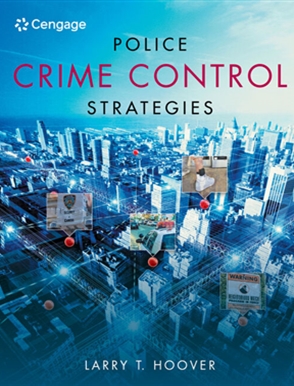Effective Directives For Faster Crime Control: Strategies And Implementation

Table of Contents
Enhancing Law Enforcement Capacity and Training
Effective crime control starts with a well-equipped and highly trained law enforcement agency. This involves significant investment in both technology and personnel development.
Investing in Technology
Modernizing police forces with advanced technology is crucial for faster response times, improved crime analysis, and enhanced officer safety. This includes:
- Body cameras: Provide transparency and accountability, deterring misconduct and offering crucial evidence in investigations. However, data storage and privacy concerns need careful consideration.
- Improved crime mapping software: Allows for better visualization of crime patterns, enabling more effective resource allocation and targeted patrols.
- Predictive policing algorithms: Analyze historical crime data to predict potential crime hotspots, enabling proactive interventions. Ethical considerations and potential biases must be addressed.
- Real-time data sharing between agencies: Facilitates faster information exchange and coordinated responses to criminal activities across jurisdictions, improving overall crime control effectiveness.
Implementing these technologies requires careful planning, addressing costs, training, and data privacy concerns. The benefits, however, outweigh the challenges, leading to more effective crime prevention and improved public safety.
Advanced Training Programs
Equipping officers with specialized training is paramount for effective crime control and community relations. This includes:
- Crisis intervention training: Enables officers to de-escalate tense situations, reducing the likelihood of violence and improving officer and citizen safety.
- De-escalation techniques: Focus on communication and conflict resolution skills to manage interactions with individuals experiencing mental health crises or emotional distress.
- Cultural sensitivity training: Promotes understanding and respect for diverse communities, improving police-community relations and building trust.
- Advanced investigative methods: Equip officers with the skills to effectively collect and analyze evidence, leading to successful prosecutions and improved crime solution rates.
Ongoing professional development is crucial for maintaining high standards of policing and ensuring officers are equipped to handle the evolving challenges of modern crime. This investment in training directly contributes to more effective crime control and fosters a more positive relationship between law enforcement and the community.
Strengthening Community Partnerships and Engagement
Effective crime control is not solely the responsibility of law enforcement; it requires a strong partnership with the community.
Community Policing Initiatives
Fostering collaboration between law enforcement and community members is crucial for crime prevention. This includes:
- Neighborhood watch programs: Empower residents to actively participate in crime prevention by reporting suspicious activities and fostering a sense of community responsibility.
- Community forums: Provide platforms for open dialogue between law enforcement and residents, addressing concerns and building trust.
- Youth outreach programs: Engage young people through positive activities, mentoring, and educational initiatives to prevent them from engaging in criminal behavior.
- Collaborative problem-solving initiatives: Address specific community concerns through collaborative efforts between law enforcement, community leaders, and residents.
Building trust and open communication channels is essential for effective community policing and creating a safer environment for everyone.
Citizen Reporting and Feedback Mechanisms
Efficient reporting systems empower citizens to actively participate in crime prevention. This involves:
- Anonymous tip lines: Allow citizens to report criminal activities without fear of retribution.
- Online crime reporting portals: Provide convenient and accessible channels for reporting incidents.
- Mobile apps for reporting incidents: Facilitate quick and easy reporting of crimes and suspicious activities.
- Community feedback surveys: Gather feedback on police services and identify areas for improvement.
Technology plays a vital role in facilitating citizen participation, but data security and privacy must be carefully managed to maintain public trust.
Improving Criminal Justice System Efficiency
An efficient criminal justice system is crucial for faster and more effective crime control.
Streamlining the Judicial Process
Reducing bottlenecks in the judicial system ensures faster case processing and quicker resolutions:
- Investing in court technology: Improves case management, reduces paperwork, and streamlines administrative processes.
- Reducing case backlogs: Prioritizing cases and implementing efficient scheduling practices to minimize delays.
- Improving plea bargain processes: Facilitates faster resolution of cases while ensuring fair outcomes.
- Alternative dispute resolution methods: Offer alternative solutions for resolving certain types of cases, reducing the burden on the court system.
A more efficient judicial system ensures that criminals are brought to justice quickly and effectively, contributing significantly to effective crime control.
Effective Sentencing and Rehabilitation Programs
Balancing punishment and rehabilitation is crucial for reducing recidivism:
- Evidence-based sentencing guidelines: Utilize data and research to develop sentencing strategies that are effective and fair.
- Rehabilitation programs in prisons: Provide educational and vocational training, substance abuse treatment, and mental health services to help offenders reintegrate into society.
- Job training initiatives for released offenders: Assist ex-offenders in finding employment, reducing their likelihood of reoffending.
- Community reintegration programs: Provide support and guidance to ex-offenders as they transition back into their communities.
Individualized approaches are key to successful rehabilitation, reducing recidivism and contributing to safer communities.
Data-Driven Crime Analysis and Prevention
Utilizing data analysis for crime prevention is a crucial aspect of effective crime control strategies.
Crime Mapping and Hotspot Identification
Identifying crime hotspots allows for targeted resource allocation and proactive policing:
- Utilizing crime mapping software: Visualize crime patterns and identify high-risk areas.
- Analyzing crime trends: Identify patterns and trends to predict potential future crimes.
- Deploying resources to high-risk areas: Allocate police resources strategically to address crime hotspots.
- Implementing preventative measures in identified hotspots: Develop and implement strategies to reduce crime in high-risk areas.
Data-driven decision-making improves the effectiveness and efficiency of crime prevention efforts.
Predictive Policing and Crime Forecasting
Using data to predict potential crime trends enables proactive intervention:
- Employing predictive policing algorithms: Analyze historical crime data to identify patterns and predict future crime events.
- Utilizing historical crime data: Identify trends and patterns to inform crime prevention strategies.
- Identifying patterns and trends: Analyze data to understand the factors contributing to crime.
- Deploying resources strategically to prevent crime before it occurs: Proactive deployment of resources to prevent crime before it happens.
While predictive policing offers significant potential, it's crucial to address ethical considerations and potential biases to ensure fairness and avoid discriminatory practices.
Conclusion
Implementing effective crime control strategies requires a multi-faceted approach. By enhancing law enforcement capacity, strengthening community partnerships, improving the efficiency of the criminal justice system, and leveraging data-driven analysis, we can significantly reduce crime rates and create safer communities. Investing in these strategies is an investment in the future, ensuring a safer and more secure environment for everyone. Let's commit to developing and implementing more effective crime control measures to build stronger and safer communities together. The future of public safety relies on our collective commitment to effective crime control strategies.

Featured Posts
-
 Binance Bitcoin Buy Orders Exceed Sell Orders After Six Month Drought
May 08, 2025
Binance Bitcoin Buy Orders Exceed Sell Orders After Six Month Drought
May 08, 2025 -
 Predicting The Arsenal Vs Psg Champions League Semi Final
May 08, 2025
Predicting The Arsenal Vs Psg Champions League Semi Final
May 08, 2025 -
 Pnjab 8 Ays Pyz Awr 21 Dy Ays Pyz Ke Tqrr W Tbadle Ka Nwtyfkyshn Jary
May 08, 2025
Pnjab 8 Ays Pyz Awr 21 Dy Ays Pyz Ke Tqrr W Tbadle Ka Nwtyfkyshn Jary
May 08, 2025 -
 Smokey Robinson Accused Of Sexual Assault Details Of The Allegations
May 08, 2025
Smokey Robinson Accused Of Sexual Assault Details Of The Allegations
May 08, 2025 -
 Daily Lotto Results Thursday April 17th 2025
May 08, 2025
Daily Lotto Results Thursday April 17th 2025
May 08, 2025
